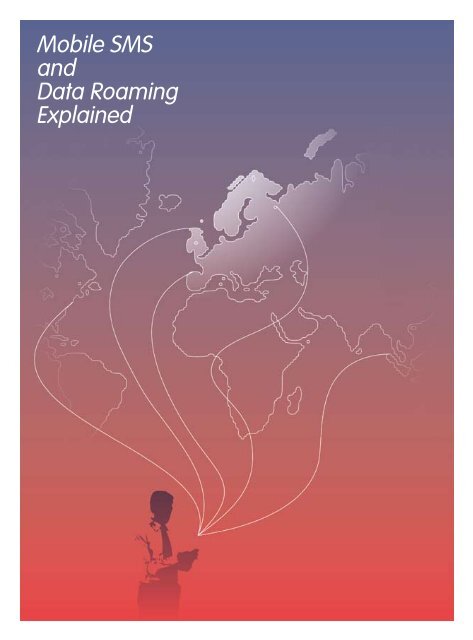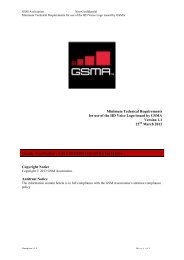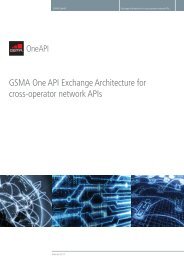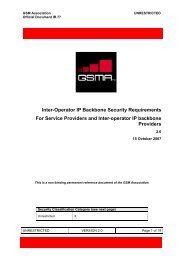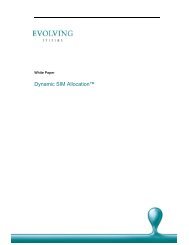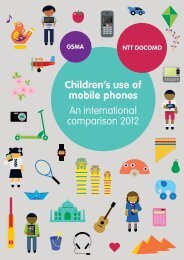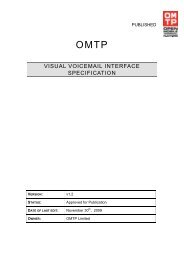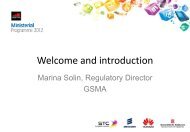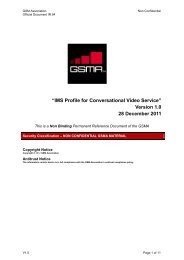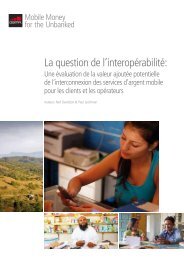Mobile SMS and Data Roaming Explained - GSMA
Mobile SMS and Data Roaming Explained - GSMA
Mobile SMS and Data Roaming Explained - GSMA
You also want an ePaper? Increase the reach of your titles
YUMPU automatically turns print PDFs into web optimized ePapers that Google loves.
<strong>Mobile</strong> <strong>SMS</strong><br />
<strong>and</strong><br />
<strong>Data</strong> <strong>Roaming</strong><br />
<strong>Explained</strong>
<strong>Mobile</strong> <strong>SMS</strong> <strong>and</strong> data<br />
roaming explained<br />
<strong>Roaming</strong> is the ability of customers to use their mobile<br />
phones or other mobile devices outside the geographical<br />
coverage area provided by their normal network operator.<br />
When customers travel abroad <strong>and</strong> use their phones or<br />
laptops whilst on a foreign (“visited”) network, this is known<br />
as international roaming.<br />
Sending <strong>and</strong> receiving <strong>SMS</strong> text messages whilst roaming<br />
abroad is called <strong>SMS</strong> roaming. <strong>Data</strong> roaming refers to the<br />
use of mobile data services whilst abroad. The most common<br />
mobile data roaming services are:<br />
• MMS: Exchanging rich multimedia messages while<br />
abroad with other customers on GSM/3G networks at<br />
home or abroad.<br />
• Push e-mail: Reading <strong>and</strong> replying to e-mails while<br />
abroad, automatically ‘pushed’ to mobile devices such as<br />
BlackBerries, personal digital assistants <strong>and</strong> sophisticated<br />
mobile phones.<br />
• H<strong>and</strong>set internet: Using mobile devices to access internet<br />
services such as Web pages, Web 2.0 applications, music<br />
downloads <strong>and</strong> video streaming whilst abroad.<br />
• <strong>Mobile</strong> broadb<strong>and</strong>: Connecting laptops via data cards or<br />
USB dongles to the internet to provide access to common<br />
applications such as e-mail, Web browsers <strong>and</strong> company<br />
networks whilst abroad.<br />
The usage of mobile data services is typically measured<br />
in kilobytes (KB) <strong>and</strong> megabytes (MB), which refers to the<br />
volume of data transmitted for the service used. An e-mail<br />
without an attachment is typically between 1 <strong>and</strong> 50KB; an<br />
average web page can use several 100KBs or even more<br />
depending on the number of graphical elements; <strong>and</strong> a<br />
downloaded song usually consumes 2 to 5MBs of data,<br />
depending on quality <strong>and</strong> length.<br />
Clearly, the traffic volumes involved in one typical day of data<br />
roaming can vary significantly depending on the type <strong>and</strong><br />
usage intensity of the different data services.<br />
Sending or receiving MMS or push e-mail typically uses<br />
several 10KBs per day unless large files are attached.<br />
Surfing the internet on a h<strong>and</strong>set can incur data volumes<br />
of a few 100KBs per day, but can also require several MBs<br />
if rich multimedia content such as MP3 songs <strong>and</strong> video<br />
streams are downloaded. <strong>Mobile</strong> broadb<strong>and</strong> volumes can<br />
quickly exceed 10MBs, as laptop-based applications such as<br />
downloading presentations, pictures, music <strong>and</strong> videos are<br />
typically very data-intensive.<br />
As a result of the trend towards higher volumes of data<br />
downloaded, operators have introduced innovative tariff<br />
packages, including flat rate daily bundles, which deliver<br />
much lower prices per MB downloaded than were previously<br />
available.<br />
2
What tariffs for <strong>SMS</strong><br />
<strong>and</strong> data roaming<br />
do operators offer?<br />
Operators offer a wide variety of data roaming tariffs catering for different data services <strong>and</strong> needs. Customers should get to<br />
know the array of tariffs available on the market in order to select the package that best suits their needs. Most tariffs fall into<br />
one of the categories shown in the following table:<br />
Type of tariff<br />
St<strong>and</strong>ard roaming tariff<br />
Special roaming tariff<br />
Daily roaming bundles<br />
Monthly roaming bundles<br />
Description<br />
The default tariff a customer would<br />
use if he has not activated a specific<br />
roaming tariff option. In this case,<br />
customers are typically charged<br />
according to how many <strong>SMS</strong> or MMS<br />
they have sent or how much data they<br />
have downloaded or uploaded<br />
For a fixed fee (typically monthly) the<br />
customer gets a lower data roaming<br />
tariff (increasingly combined with<br />
domestic data tariffs)<br />
A fee for a single day of data<br />
roaming, which allows data roaming,<br />
up to a specified data usage limit, for<br />
a fixed fee<br />
A fixed monthly fee, which includes<br />
a certain amount of data that can be<br />
used within each month while roaming<br />
General suitability<br />
These tariffs are typically best suited<br />
for occasional roaming with low<br />
volume usage<br />
These tariffs are aimed at regular use<br />
with low to average volume usage<br />
These tariffs are ideal for the occasional<br />
roamer with a high data volume<br />
requirement on particular days from<br />
time to time<br />
A regular roamer with high data<br />
volumes would typically subscribe to<br />
such a tariff<br />
Tariffs can be identical for all data services or different for the various data services. Some operators, for example, offer daily<br />
roaming bundles for laptop connectivity <strong>and</strong> monthly bundles for push e-mail roaming. For <strong>SMS</strong>, most operators do not charge<br />
for receiving an <strong>SMS</strong> while roaming, in much the same way as there is usually no charge for receiving an <strong>SMS</strong> at home.<br />
3
How does <strong>SMS</strong> <strong>and</strong><br />
data roaming work?<br />
<strong>SMS</strong> <strong>and</strong> data roaming build upon the same principles<br />
used to enable voice roaming. When you travel abroad<br />
<strong>and</strong> you turn your h<strong>and</strong>set or laptop on, it attempts to<br />
communicate with a GSM or 3G network. Your h<strong>and</strong>set may<br />
be preconfigured to actively choose a preferred network in<br />
the visited country, but you can choose your own preferred<br />
network via the h<strong>and</strong>set menu.<br />
The visited (local) network picks up the signal from your<br />
device, notes that you are a visitor <strong>and</strong> attempts to identify<br />
your home network. If there is a data roaming agreement<br />
between your home network <strong>and</strong> the visited network abroad<br />
<strong>and</strong> your network operator allows you to roam, your device<br />
will then be able to access data roaming services. In some<br />
cases, the visited network may only offer basic data services<br />
such as <strong>SMS</strong> <strong>and</strong> GPRS-enabled services, such as e-mail, but<br />
not 3G/mobile broadb<strong>and</strong> services (e.g. if the visited operator<br />
has not rolled out a 3G network or if the home <strong>and</strong> visited<br />
operators have not yet signed a 3G roaming agreement).<br />
What happens when you send an <strong>SMS</strong><br />
while abroad?<br />
• When you are abroad <strong>and</strong> you send an <strong>SMS</strong> home to<br />
a friend, your <strong>SMS</strong> is managed by the visited operator’s<br />
network as well as by your home operator’s network.<br />
• The visited network passes the <strong>SMS</strong> via dedicated<br />
signalling links to your home network.<br />
• Your home network sends the <strong>SMS</strong> to your friend’s<br />
network, which delivers it to your friend’s mobile phone.<br />
What happens when you receive an <strong>SMS</strong><br />
while abroad?<br />
• A friend sends an <strong>SMS</strong> to your mobile phone while you<br />
are roaming.<br />
• His operator’s network contacts your home network to<br />
find out where you are, <strong>and</strong> then routes the <strong>SMS</strong> to the<br />
network you are roaming on in the visited country.<br />
• The visited network delivers your friend’s <strong>SMS</strong> to your<br />
mobile phone.<br />
What happens when you send an MMS<br />
while abroad?<br />
• When abroad <strong>and</strong> sending an MMS home to a friend,<br />
your MMS is managed by the visited operator’s network<br />
as well as by your home operator’s network.<br />
• The visited network passes the MMS via international data<br />
transit (typically an international cable owned by a third<br />
party) to your home network.<br />
• Your home network sends the MMS to your friend’s<br />
network, which delivers it to your friend’s mobile phone.<br />
4
What happens when you receive an MMS<br />
while abroad?<br />
• A friend sends an MMS to your mobile phone while you<br />
are roaming. His operator’s network routes the MMS via<br />
international data transit to your home network.<br />
• Your home network sends an <strong>SMS</strong> notification to your<br />
mobile phone abroad.<br />
• Once your mobile phone has acknowledged the <strong>SMS</strong><br />
receipt, the MMS is passed from your home network via<br />
international data transit to your mobile phone.<br />
The visited network operator then uses these details to<br />
calculate the wholesale roaming charge payable by your<br />
home network. The data records, including the applicable<br />
wholesale charges, will be saved in a Transferred Account<br />
Procedure (TAP) file.<br />
TAP files are sent from the visited network to your home<br />
network, typically by using the services of a data clearing<br />
house. A data clearing house acts as a ‘hub’ for the<br />
distribution of TAP files <strong>and</strong> provides the home network with<br />
services such as reporting to assist the home network in<br />
running its roaming business. Your home network then pays<br />
the visited network the appropriate wholesale charges.<br />
What is the difference between pre-paid <strong>and</strong><br />
post-paid roaming?<br />
<strong>Roaming</strong> for pre-paid customers is a more recent<br />
development <strong>and</strong> involves additional investment by<br />
operators. This is because roaming signalling <strong>and</strong> billing<br />
systems are more complex for pre-paid services than they<br />
are for post-paid services.<br />
What happens when you use the mobile<br />
internet abroad?<br />
• When abroad <strong>and</strong> accessing the mobile internet, including<br />
push e-mail, h<strong>and</strong>set internet <strong>and</strong> mobile broadb<strong>and</strong><br />
services, also called Packet Switched <strong>Data</strong> (PSD), your<br />
connection is established by the visited operator’s network<br />
back to your home operator’s network.<br />
• The visited operator’s network passes your internet traffic<br />
via international data transit to <strong>and</strong> from your home<br />
network.<br />
• Your home network connects you to the internet, your<br />
e-mail account(s) <strong>and</strong> other data services.<br />
For post-paid roaming, when the user first switches their<br />
phone on, the visited network checks in real time whether the<br />
home network authenticates the customer <strong>and</strong> authorises its<br />
use abroad. But the data records (CDRs) with the details on<br />
each <strong>SMS</strong> <strong>and</strong> data session are sent to the home operator<br />
with some delay (up to several days).<br />
For pre-paid roaming, in addition to the initial authentication<br />
step, the call-related data must be exchanged in real time<br />
between the visited network <strong>and</strong> the home network by using<br />
a special platform (called CAMEL – Customized Applications<br />
for <strong>Mobile</strong> networks Enhanced Logic), to prevent the<br />
balance of the roaming customer’s account from becoming<br />
overdrawn.<br />
What are wholesale charges <strong>and</strong> how do<br />
operators set them?<br />
Wholesale charges represent the fees the visited network<br />
charges the home network for letting the home network’s<br />
customers roam on its network.<br />
These inter-operator tariffs (IOTs) are agreed bilaterally<br />
between the home <strong>and</strong> visited network operators. Operators<br />
often negotiate competitive incentives, for instance, discounts<br />
relating to the volume of traffic passed between operators or<br />
lower costs for longer sessions.<br />
How do network operators exchange billing<br />
information for roaming customers?<br />
For all data services (<strong>and</strong> voice calls), the visited network<br />
captures the details of every session in a Call Detail Record<br />
(CDR). These record information on the location, sending<br />
party, receiving party, time of connection, session duration<br />
<strong>and</strong> size (measured in KB or MB).<br />
Wholesale charges are paid to the visited network by the<br />
home network, irrespective of whether the home network<br />
recovers any fees from its roaming customers.<br />
5
Who pays for what?<br />
Selected key elements<br />
enabling <strong>SMS</strong> <strong>and</strong> data<br />
roaming<br />
• Signalling network: Services<br />
which enable the exchange of<br />
roaming related signalling traffic<br />
between the home network <strong>and</strong><br />
the visited networks.<br />
• Home Location Registers (HLRs):<br />
These are databases used<br />
to store customers’ profiles.<br />
Communication between these<br />
databases <strong>and</strong> Visitor Location<br />
Registers of the visited network<br />
allows roaming to take place.<br />
• Visitor Location Registers (VLRs):<br />
These are databases used<br />
to store information about<br />
customers, including those who<br />
roam. Communication between<br />
these databases <strong>and</strong> HLRs of the<br />
home network allows roaming to<br />
take place.<br />
• <strong>SMS</strong> welcome servers: Operators<br />
use these computer servers to<br />
identify <strong>and</strong> send <strong>SMS</strong> messages<br />
to roaming customers upon<br />
arrival in the visited country.<br />
• Traffic management platforms:<br />
These services allow operators to<br />
determine preferred networks for<br />
roaming <strong>and</strong> manage roaming<br />
traffic distribution.<br />
• International transit: Every time<br />
data is transferred between the<br />
visited country <strong>and</strong> the home<br />
country, an international data<br />
transit/backbone network is used.<br />
• <strong>Data</strong> clearing house: A third party<br />
that acts as a hub for reporting,<br />
the exchange of data records<br />
(CDRs) <strong>and</strong> settlement between<br />
operators.<br />
Sending <strong>and</strong> receiving <strong>SMS</strong><br />
When a customer sends an <strong>SMS</strong> while roaming, the retail<br />
price he pays reflects several cost elements: the wholesale<br />
charge for using the visited network, costs of h<strong>and</strong>ling <strong>and</strong><br />
routing the roaming <strong>SMS</strong> back to the home network, costs<br />
for sending the <strong>SMS</strong> to the receiver’s network, data clearing<br />
house fees, signalling fees between the networks <strong>and</strong> other<br />
costs (e.g. commercial costs, IT costs, prepay checks), the<br />
home operator’s retail costs <strong>and</strong> taxes, such as VAT.<br />
Most operators do not charge for receiving an <strong>SMS</strong> while<br />
roaming. The sender of the <strong>SMS</strong> also only pays the usual<br />
price as if the receiving customer were on their home<br />
network. Hence mobile operators bear the additional costs<br />
of h<strong>and</strong>ling the received roaming <strong>SMS</strong> without charging<br />
customers for it.<br />
Sending <strong>and</strong> receiving MMS<br />
When a customer sends a MMS while roaming, the retail<br />
price he pays reflects several elements: the wholesale charge<br />
for using the visited network, costs for international transit<br />
of the roaming MMS back to the home network, costs for<br />
sending the MMS to the receiver’s network, data clearing<br />
house fees, signalling fees between the networks <strong>and</strong> other<br />
costs (e.g. commercial costs, IT costs, prepay checks), the<br />
home operator’s retail costs <strong>and</strong> taxes, such as VAT.<br />
Using internet data services<br />
When a customer connects to the internet while roaming, for<br />
example to receive push e-mail or read the news, the retail<br />
price he pays has to cover the following elements: signalling<br />
network fees, the wholesale charge for using the data<br />
connection on the visited network, costs for the international<br />
transit of the data, costs for connecting to the internet from<br />
the home network, data clearing house fees, other costs<br />
(e.g. commercial costs, IT costs, prepay checks), the home<br />
operator’s retail costs <strong>and</strong> taxes, such as VAT.<br />
The usage of internet data services is generally measured by<br />
data volume usage, which is highly dependent on the type<br />
of device <strong>and</strong> services used. Checking e-mails, for example,<br />
typically uses less data than downloading an MP3 song.<br />
The visited network operator, however, has no visibility of<br />
what type of data services visiting customers are using <strong>and</strong><br />
therefore the wholesale price charged to the home operators<br />
can only be based on the data volume used per customer.<br />
When the roaming customer receives an MMS, the retail<br />
price includes the MMS cost plus the cost of an <strong>SMS</strong> sent<br />
to notify the receiving h<strong>and</strong>set that an MMS is ready to be<br />
downloaded. Some operators do not charge for receiving<br />
an MMS while roaming <strong>and</strong> therefore bear the costs of<br />
delivering the MMS without passing these on to customers.<br />
6
More information<br />
Common acronyms<br />
• 3G: Third Generation mobile network st<strong>and</strong>ards. Besides<br />
better voice quality, 3G networks allow for faster data<br />
transfer than GPRS. 3G is often also called mobile<br />
broadb<strong>and</strong>.<br />
• CAMEL: Customized Applications for <strong>Mobile</strong> networks<br />
Enhanced Logic. It is an Intelligent Network designed to<br />
work on either GSM or 3G core networks. CAMEL helps<br />
make pre-paid roaming user friendly, with features such<br />
as no-prefix dialling, real-time billing <strong>and</strong> being able to<br />
make <strong>and</strong> receive voice calls, <strong>SMS</strong>, MMS <strong>and</strong> use data<br />
services while abroad.<br />
• CDR: Call Detail Record. This is the record of a voice call or<br />
an <strong>SMS</strong>, with details such as origin, destination, duration,<br />
time of day, amount charged for each call or <strong>SMS</strong>.<br />
<strong>Roaming</strong> partners must share CDRs for accurate interoperator<br />
settlement.<br />
• GPRS: General Packet Radio Service. A packet-based<br />
mobile data service, mostly used to access e-mail <strong>and</strong><br />
the internet from mobile phones. 3G st<strong>and</strong>ards are faster<br />
alternatives to GPRS.<br />
• HLR: Home Location Registers. These are databases used<br />
to store customers’ profiles. Communications between<br />
these databases <strong>and</strong> VLRs of the visited network allows<br />
roaming to take place.<br />
• IOT: Inter Operator Tariff. This is the wholesale fee that<br />
the visited network operator charges the home network<br />
operators for allowing the roaming customer to make<br />
calls or use data services.<br />
• IP: Internet Protocol. This is the main protocol to enable<br />
access to the internet <strong>and</strong> the Web. It is used in<br />
combination with GPRS/3G data transfers.<br />
• KB: Kilobyte. Measure for the size of data uploads <strong>and</strong><br />
downloads. One KB equals 1,000 bytes with each byte<br />
carrying the equivalent of one single character such as the<br />
letter ‘A’.<br />
• MB: Megabyte. Measure for the size of data uploads <strong>and</strong><br />
downloads. One MB equals 1,000 KB.<br />
• MMS: Multimedia Messaging Service. This is an extension<br />
of <strong>SMS</strong>, which uses an <strong>SMS</strong> to notify the mobile device<br />
of a new MMS <strong>and</strong> GPRS or 3G to download the actual<br />
message <strong>and</strong> the included multimedia content.<br />
• MO: <strong>Mobile</strong> Originated. Refers to any communication<br />
whether voice, messaging or data, that is initiated by a<br />
mobile phone.<br />
• MT: <strong>Mobile</strong> Terminated. Refers to any communication<br />
whether voice, messaging or data, that is terminated on a<br />
mobile phone.<br />
• MTR: <strong>Mobile</strong> Termination Rate. This is the fee charged by<br />
mobile operators to terminate a call on their network.<br />
• PSD: Packet Switched <strong>Data</strong>. Describes data services that<br />
use a combination of GPRS/3G <strong>and</strong> IP, such as push<br />
e-mail or mobile web browsing.<br />
• <strong>SMS</strong>: Short Message Service. Popular service to send short<br />
messages (each 160 characters) directly from one mobile<br />
phone to another.<br />
• TAP: Transferred Account Procedure. The TAP is the<br />
mechanism by which operators exchange roaming billing<br />
information (CDRs). This is how roaming partners are able<br />
to bill each other for the use of networks <strong>and</strong> services<br />
through a st<strong>and</strong>ard process.<br />
• VLR: Visiting Location Registers. These are local databases<br />
used to temporarily store information about customers,<br />
including roaming customers. Communication between<br />
these databases <strong>and</strong> HLRs of the home network allows<br />
roaming to take place.<br />
7
GSM Facts<br />
About 70,000 new GSM connections<br />
are made globally every hour<br />
(Source: Wireless Intelligence 2008)<br />
There are over 3 billion GSM <strong>and</strong> 3G<br />
connections globally<br />
(Source: Wireless Intelligence 2008)<br />
European mobile subscribers<br />
Population of Europe: 500 million<br />
(EU27 + Icel<strong>and</strong>, Liechtenstein,<br />
Norway, Source: Eurostat 2007)<br />
Number of SIMs in Europe:<br />
594 million (EU27 + Icel<strong>and</strong>,<br />
Liechtenstein, Norway,<br />
Source: Wireless Intelligence 2007)<br />
Where to go for more<br />
information<br />
To help mobile phone customers<br />
identify <strong>and</strong> compare data roaming<br />
tariffs between operators, the<br />
<strong>GSMA</strong> has set up an independent<br />
website with regularly updated tariff<br />
information:<br />
www.roaming.gsmeurope.org<br />
For further questions on<br />
roaming please contact:<br />
roaming@gsm.org<br />
Produced by the <strong>GSMA</strong> in<br />
co-operation with A.T. Kearney


